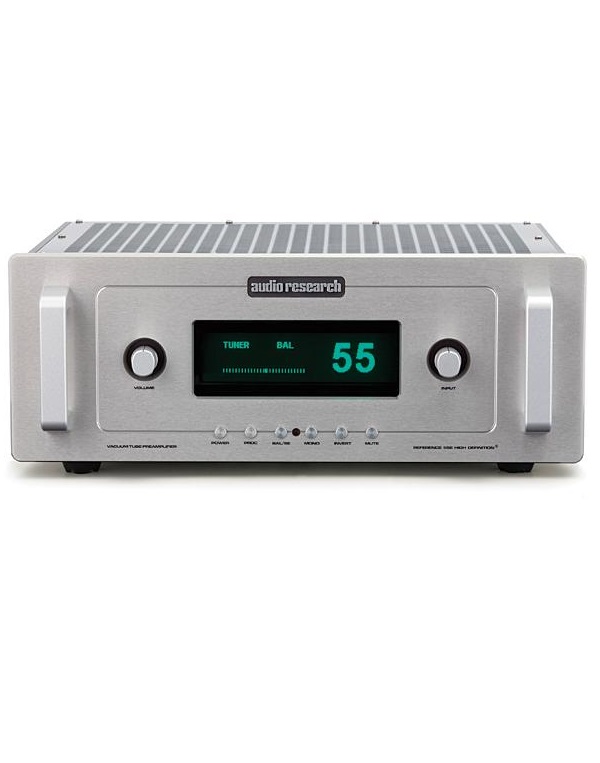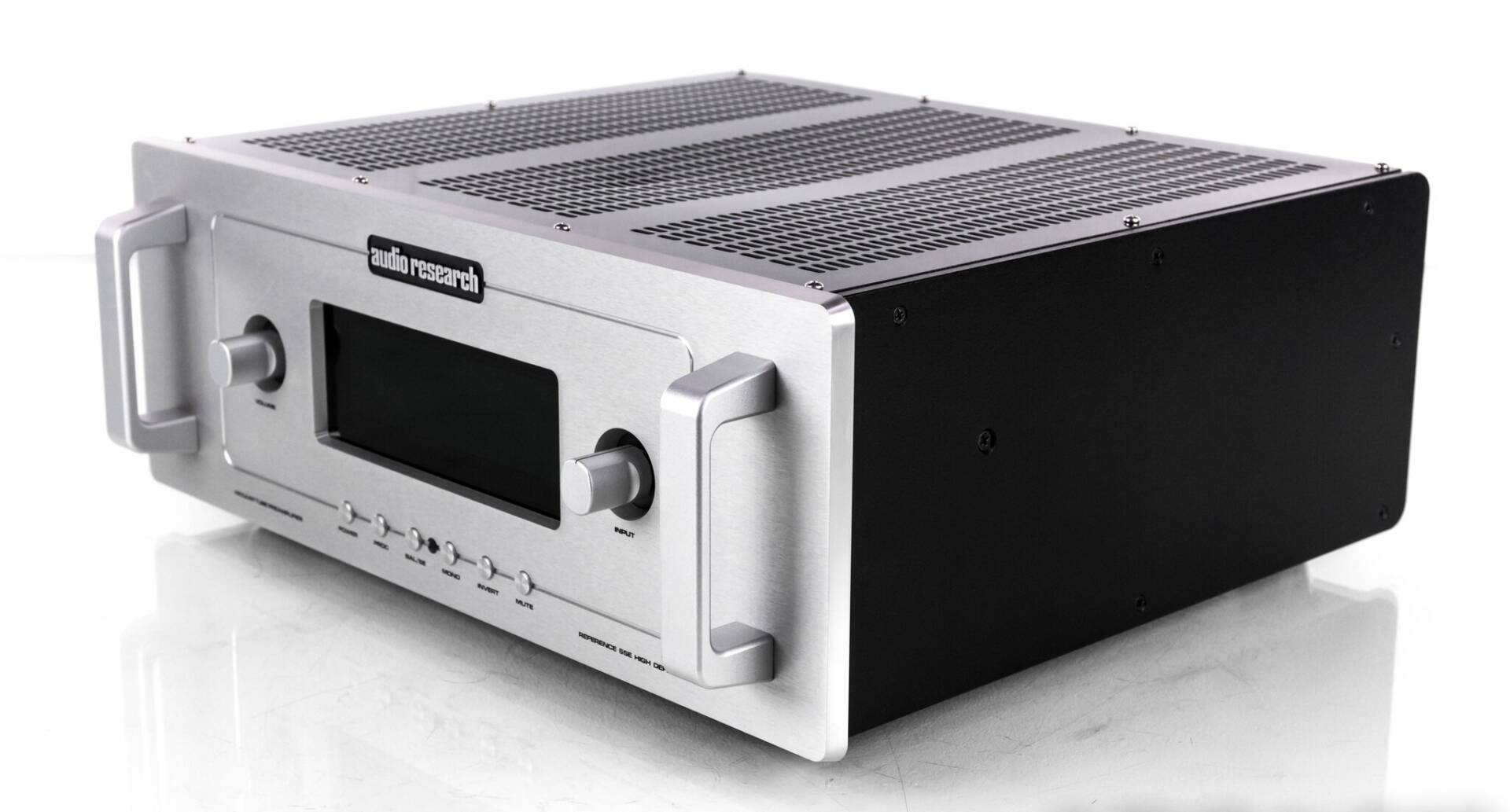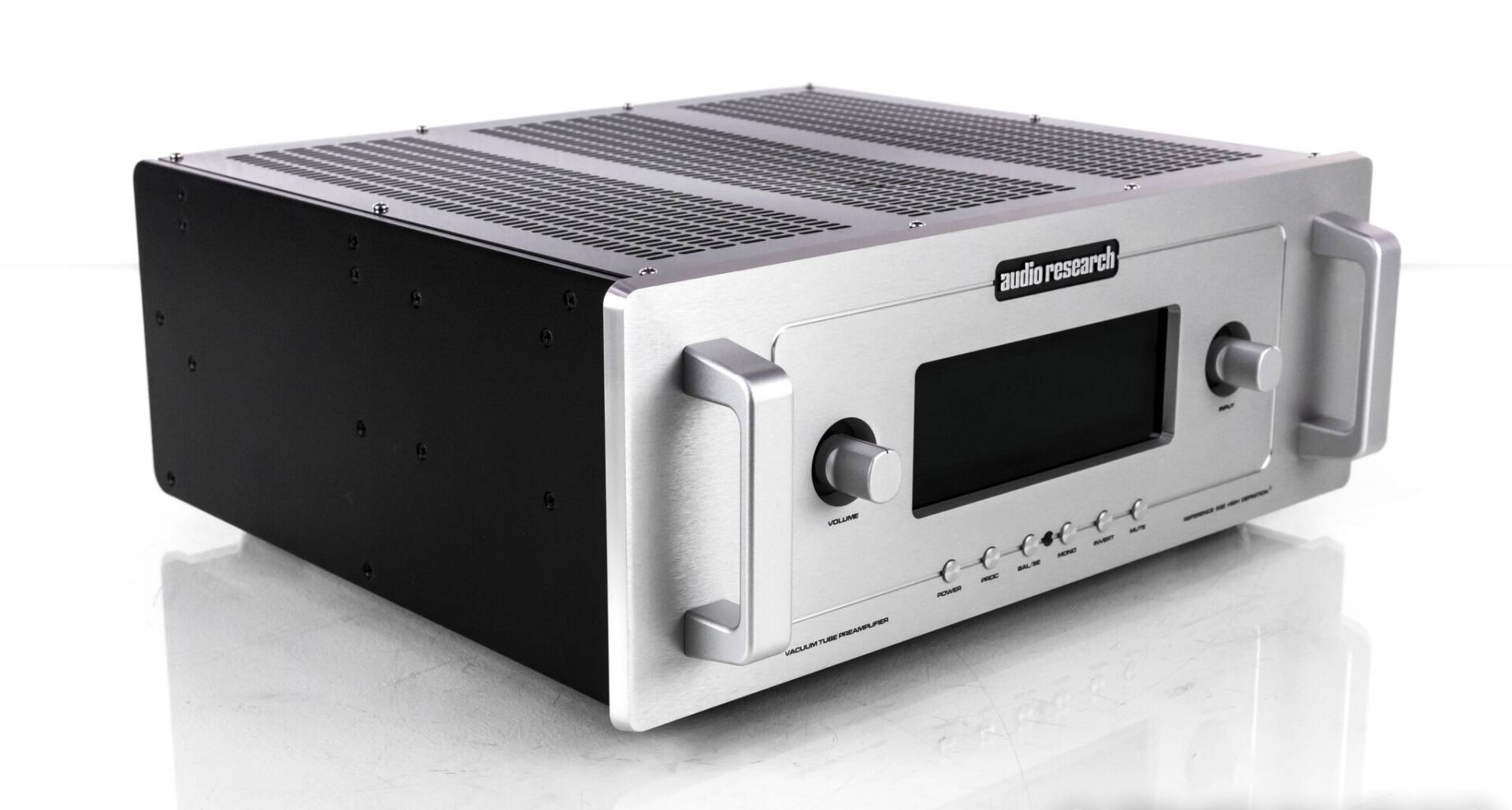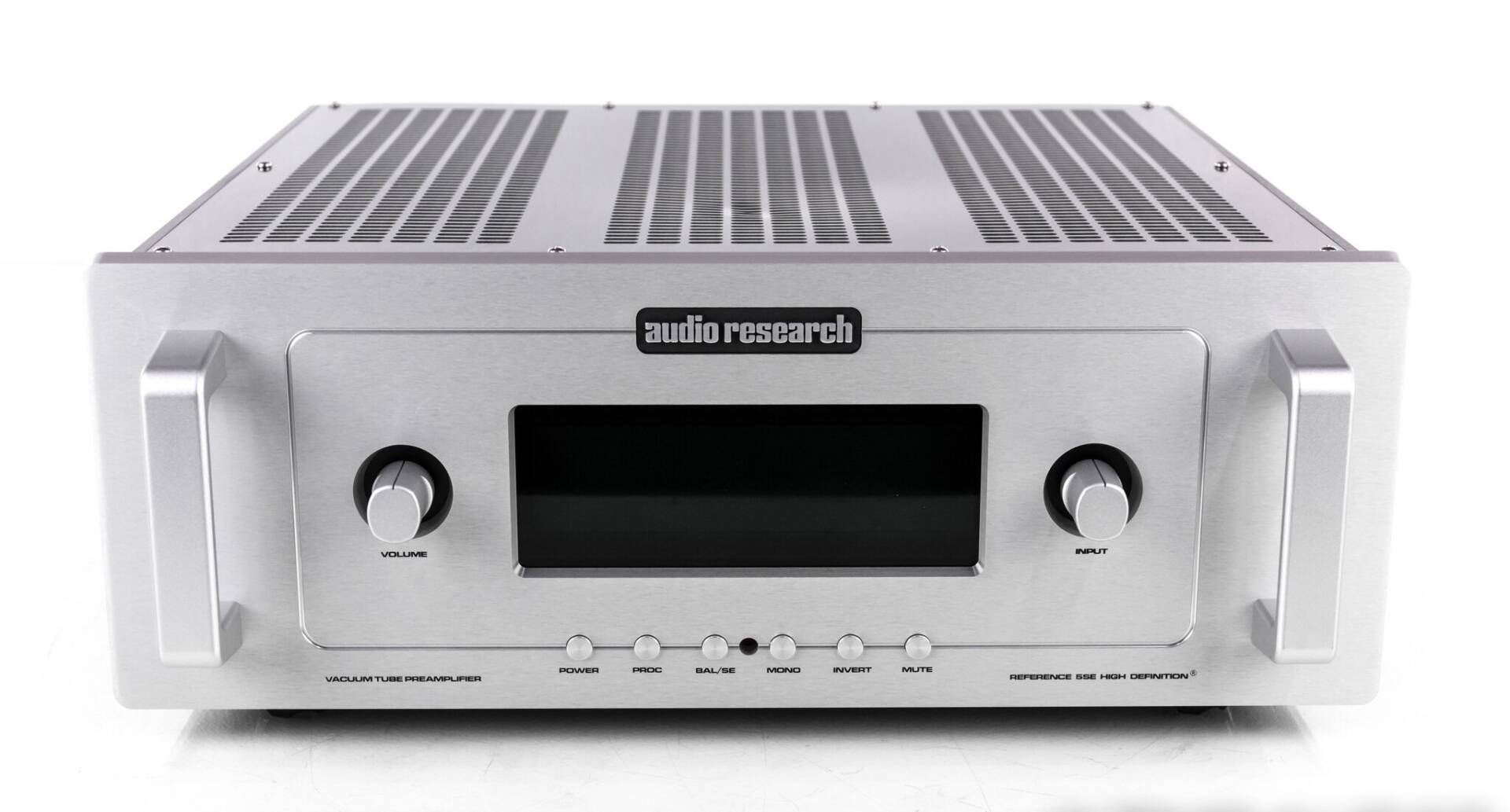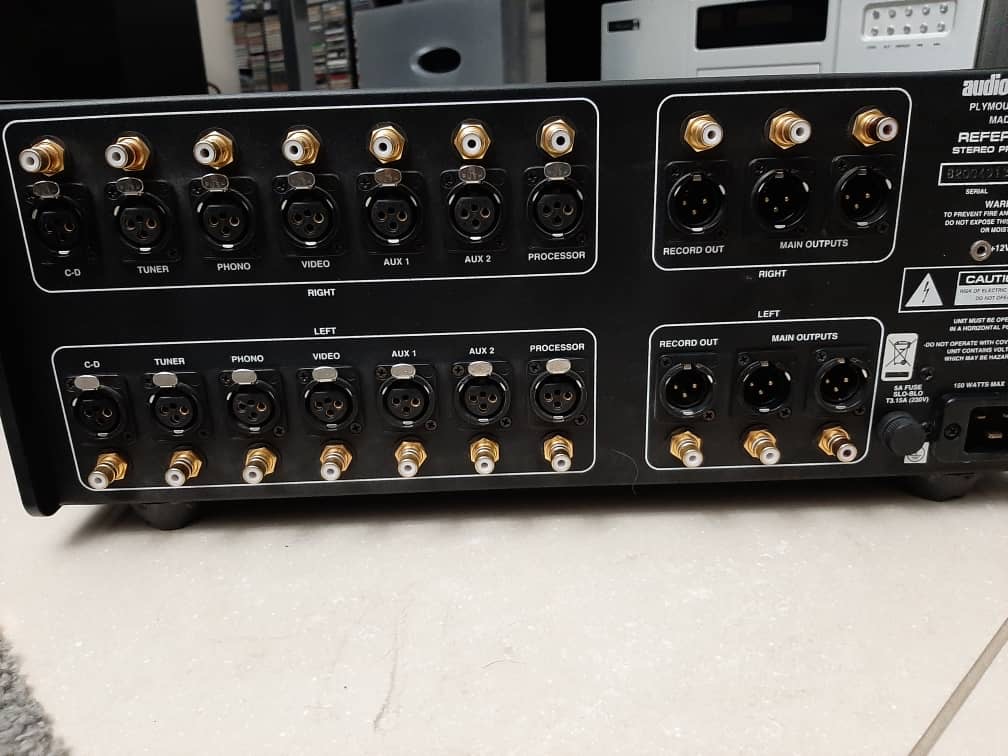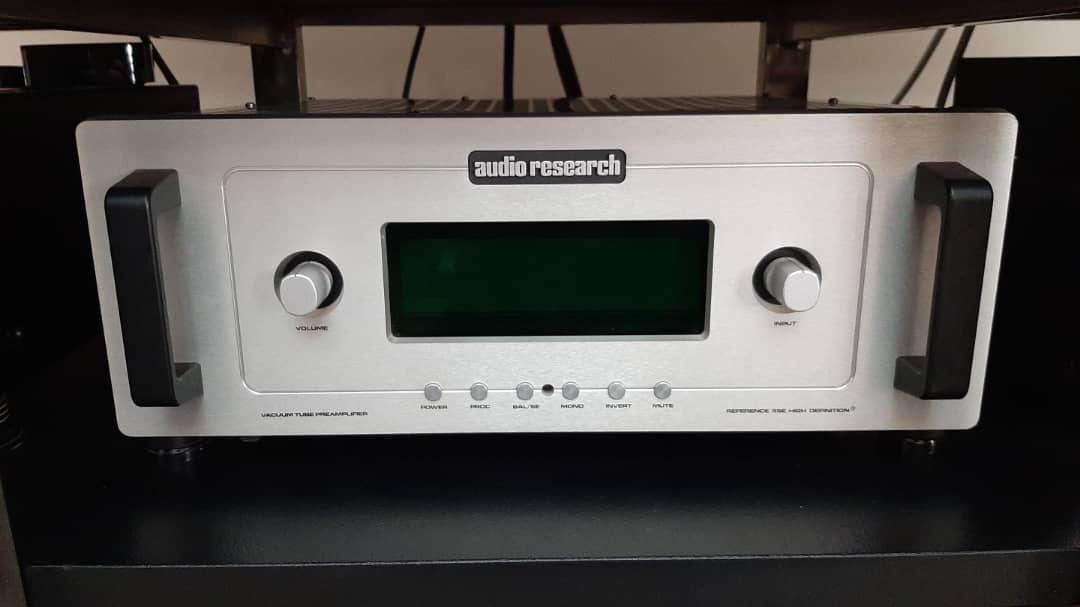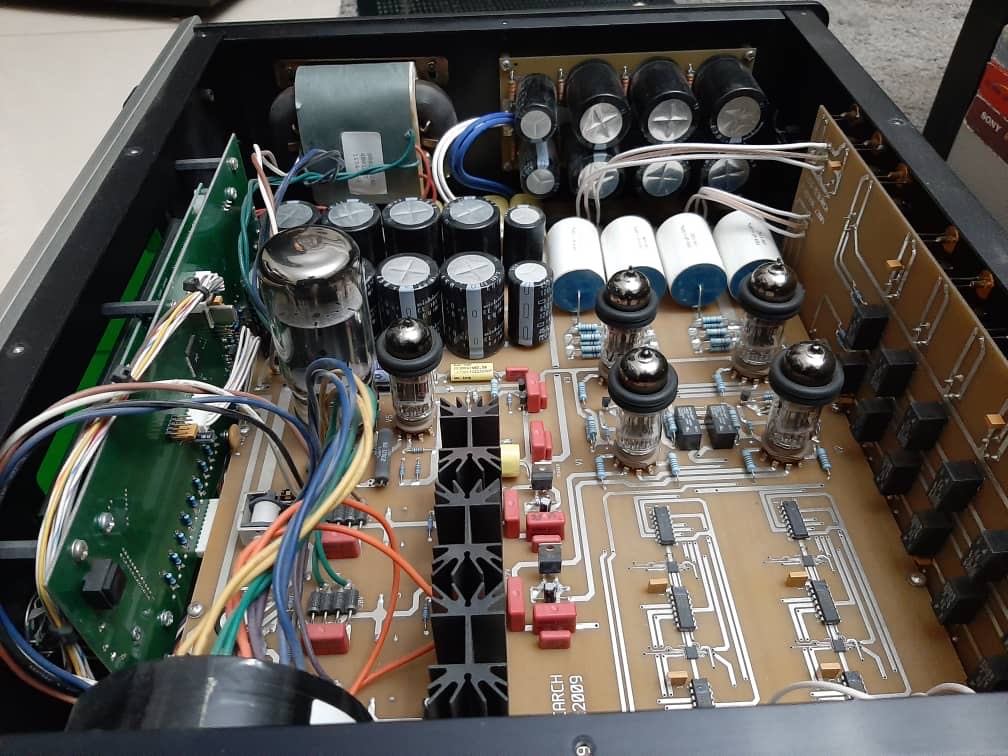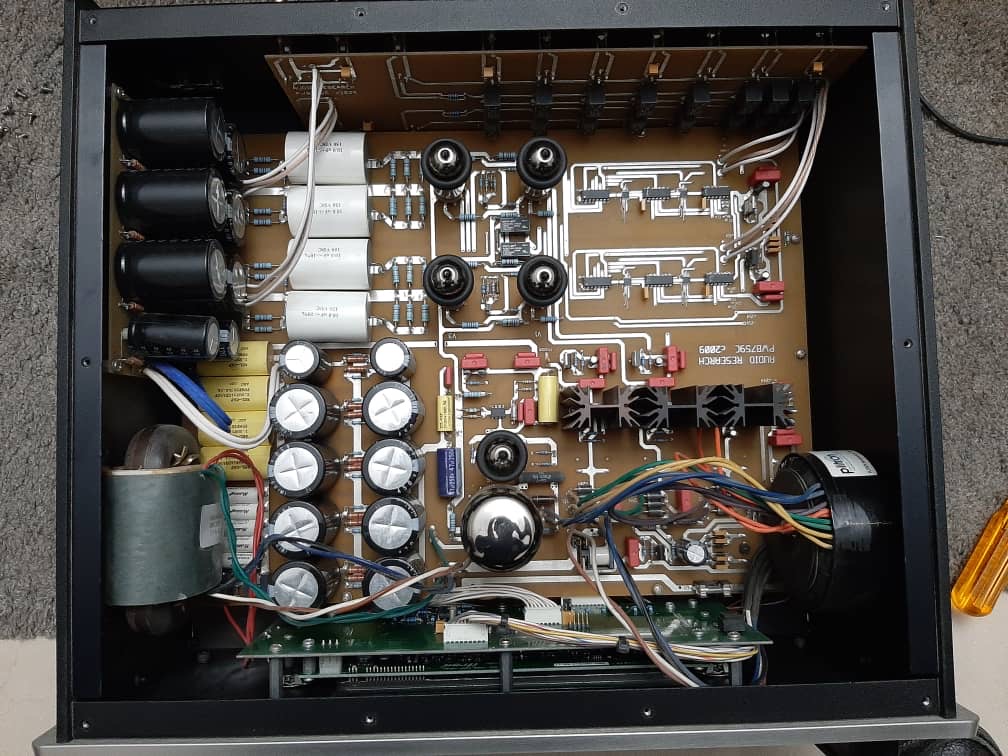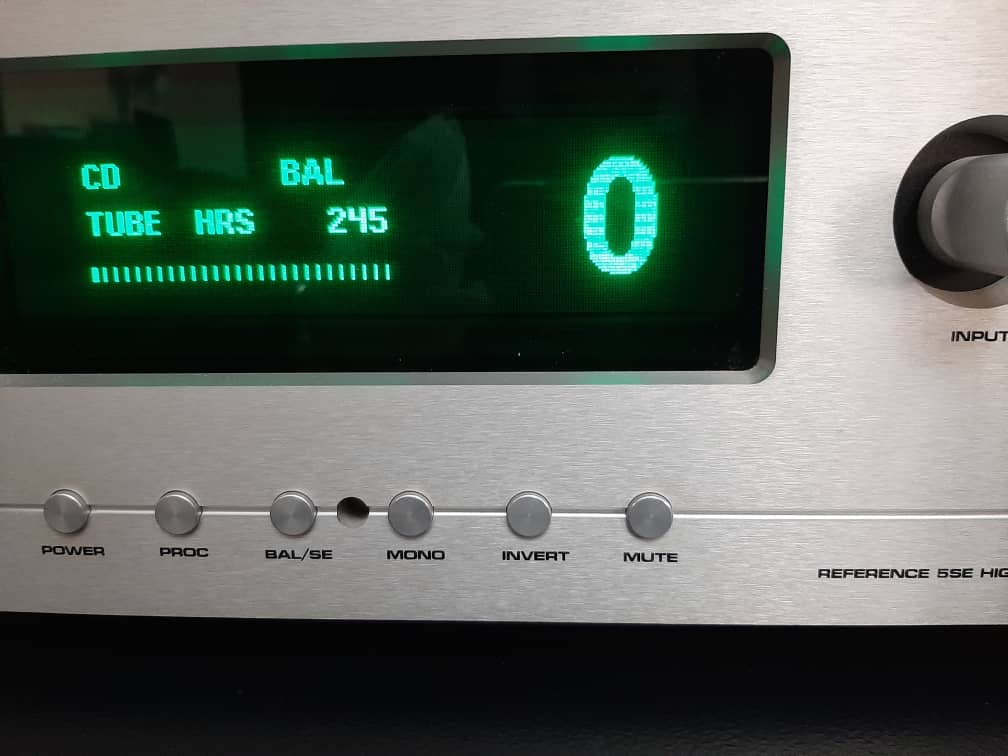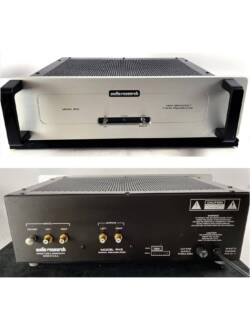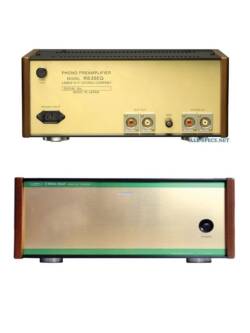Audio Research Reference 5 SE (Silver ) + Furutech
Original price was: R245,000.00.R95,000.00Current price is: R95,000.00.
Notes:
NEW Tubes
Furutech FI-50 NCF Power cable worth R20000
The Reference 5 SE
The Reference 5 SE benefits from several advancements that Audio Research developed for the cost-no-object, limited-edition Anniversary Reference preamplifier ($24,995), including two readily visible changes from the Ref 5. First, the 5 SE’s front panel mirrors that of the Anniversary: the buttons are now tidy, round, metal, and set directly into the faceplate, rather than the Ref 5’s square, recessed plastic buttons. Added on the inside, to the left, is a vertically mounted circuit board, stuffed to the gills with capacitors to nearly double the Ref 5’s already massive energy storage. Other changes include new Teflon and hybrid coupling and bypass capacitors, and changes in the internal wiring.
Otherwise, the Reference 5 SE’s basic circuitry resembles that of the Ref 5: it’s mostly contained on a single-sided board that stretches from wall to wall. Additional, smaller boards handle I/O, switching, and display functions. As in the Ref 5, the Ref 5 SE’s transformers—an R-core for the audio circuits, a toroidal for the display, relays, and microprocessor controls—are mounted on the sides of the chassis, above the board, to reduce vibration in the audio circuits. The audio circuitry’s power supply is a hybrid-regulated design employing both FETs and a 6H30 dual-triode tube controlling a 6550 pentode tube. The audio circuit itself is “as simple and good as we could make it,” according to ARC’s David Gordon: a single gain stage with a cathode follower tube in a zero-feedback, fully balanced, pure class-A triode layout. There are six tubes: four 6H30s in the analog stage, and the 6550 and 6H30 in the power supply.
The Ref 5 SE’s cosmetics and layout are handsome in Audio Research’s traditional fashion, and it’s the same goodly size and weight as the Ref 5: 19″ wide by 7″ high by 15.5″ deep, and weighing 30 lbs. The chassis is of heavy aluminum, with a thick, elegantly machined aluminum front plate and two rack-mount handles. The review sample’s top plate was of tinted polycarbonate, with slot vents. A cover of perforated aluminum is also available, but ARC recommends the polycarbonate, perhaps because of lower chassis resonances. The Ref 5 SE is available in natural aluminum or black.
Like the Reference 5, the 5 SE has at the center of its faceplate a large window that prominently displays the volume setting with both a bar graph and large numeric display. Also displayed, in far smaller characters, are the selected input, whether it’s single-ended or balanced, and the status of several functions: mono/stereo, mute on/off, and polarity non-inverted/inverted. The display can also be used, via the remote control, to show the hours each tube has been used, handy for confirming what your ears will tell you: that you’ve reached the 600 hours of break-in time that ARC recommends. Via the remote, the display’s level of illumination can be set to one of eight levels, from off through bright. But even when the display is fully dark, any change in status lights it up for 10 seconds to display the change.

Flanking the display are two return-to-center knobs, attached to a microprocessor, that turn through an arc of about 60°. The one on the left changes the volume across 103 steps; the one on the right selects among the six inputs. Below the display are six small buttons: Power, Mute, Mono, Balanced/SE (input selection), Processor, and Phase Invert. All front-panel controls are duplicated on the utilitarian remote control, which also includes buttons for adjusting balance and display brightness, and to display tube hours.
On the rear panel are six line-level inputs, a processor input that bypasses the volume control to allow the Ref 5 SE to be integrated into a home-theater system, a set of line-level output jacks for recording, and two sets of outputs. All inputs and outputs have both single-ended and balanced connections. For each input, the type of connection is selected with the Balanced/SE button on the front panel or remote.
The Bottom Line
As I review my notes and what I’ve written here, I realize how hard it is to describe a component as good as the Ref 5 SE. It was a struggle to say anything relevant using the standard audiophile criteria and vocabulary. Over and over, I found myself simply describing what it was like to hear more of the music than before, a performance that now sounded more engaging and compelling than it ever had. The Reference 5 SE was so good, and such a complete package, that I often felt I was grasping at straws to find things to critique. In 2006, Paul Bolin said that “discovering the weaknesses of the Reference 3 will be possible only when it has been bettered.” That’s exactly where I’m at with the Reference 5 SE.
Summing up my experience of Audio Research’s Reference 5 SE preamplifier is pretty easy: I was smitten. I hear a lot of great audio gear, but it’s been a long time since I’ve been so taken with a component. I can’t imagine anyone hearing the Ref 5 SE and not falling head over heels for it. It’s been a long time, too, since I’ve heard a component that seemed to be so fundamental and significant an advance over all others I’ve heard. It’s true that I haven’t heard the latest models from Ayre Acoustics, Simaudio, Sutherland Engineering, and VTL. And $12,995 is a lot of money—but not for a component this good and this well built, and not for one that Audio Research stands behind. There are a lot more expensive preamps out there today, but I’m not sure that any amount of money will buy better performance than the Reference 5 SE’s. One thing I am sure of: Like its illustrious predecessors, the Ref 5 SE is a component I’ll wish I’d held on to—assuming I ever let go of it. The Reference 5 SE gets my highest recommendation.

If I were to single out the two things that this ARC preamp supplies that great transistor circuits usually do not (at least to the same degree), it would be precisely the same things that analog front ends supply and digital front ends typically don’t: 1) three-dimensional body and bloom; and 2) very fine resolution of low-level harmonic/dynamic information, particularly on solo instruments or small ensembles. You might not be able to count the number of peaches in the crate with the same kind of exactitude that you can with a great transistor preamp—solid-state generally has higher resolution with large groups of things, tubes with smaller groups or individual ones—but when the recording engineer zooms in for a close-up of a particular peach you’ll perceive its roundedness, its dappled colors, its “fuzzy” texture with a realism that solid-state tends to scant.
 Take Sarah Vaughn (which I would gladly have done, BTW) singing the title song from her first Pablo LP How Long Has This Been Going On? If you know Sarah’s soaring contralto, you know that she regularly added coloratura-like touches, including a throaty vibrato and a delicious head tone, to select lyrics. To hear her voice at its splendid best, you need to capture its power, its color, its range, and, for lack of better words, its volume—for all of her various coloratura touches come from slightly different places in the acoustic space that is “Sarah Vaughn on record” (and that was “Sarah Vaughn in life”). She variously uses her head, her nose, her mouth (actually various parts of her mouth, including a certain “chewiness” on select lyrics, as if she is actually tasting and savoring the words), her throat, and her chest to achieve that famous “operatic” range, timbre, and texture. In life, these things—head, nose, mouth, throat, chest—aren’t a thin flat plane in acoustic space; they aren’t even a series of planes (which is the way they are generally presented on solid-state). They are one continuous “volume,” a single three-dimensional acoustic object.
Take Sarah Vaughn (which I would gladly have done, BTW) singing the title song from her first Pablo LP How Long Has This Been Going On? If you know Sarah’s soaring contralto, you know that she regularly added coloratura-like touches, including a throaty vibrato and a delicious head tone, to select lyrics. To hear her voice at its splendid best, you need to capture its power, its color, its range, and, for lack of better words, its volume—for all of her various coloratura touches come from slightly different places in the acoustic space that is “Sarah Vaughn on record” (and that was “Sarah Vaughn in life”). She variously uses her head, her nose, her mouth (actually various parts of her mouth, including a certain “chewiness” on select lyrics, as if she is actually tasting and savoring the words), her throat, and her chest to achieve that famous “operatic” range, timbre, and texture. In life, these things—head, nose, mouth, throat, chest—aren’t a thin flat plane in acoustic space; they aren’t even a series of planes (which is the way they are generally presented on solid-state). They are one continuous “volume,” a single three-dimensional acoustic object.
With solid-state you generally (not always) get a pronounced flattening of this volume, just as you do to a greater extent with digital sources. HP once compared the effect to looking at the world through one eye, and I can’t improve on that. With the Reference 5, what seems like “one-eyed” vision becomes binocular. It is quite an amazing experience to hear Sarah go from a relatively flat image to a fully round three-dimensional one, standing in three-dimensional space and surrounded by three-dimensional space. It is also amazingly realistic. I’ve used the analogy before but it really is like the difference between looking at a large-format photograph and at a life-sized statue. The photograph, through two-dimensional, is very very finely detailed in a way that the statue isn’t and it is also very realistic. But the statue is dimensional, solid, and lifelike in a way that the photo isn’t.
Used to be that ARC preamps were primarily capable of this magical dimensionality and bloom in the midrange. Oh, they still had bloom in the low bass and the top treble, but they simultaneously lost a good deal of the image focus, definition, dynamic scale, and low-level resolution that made midband instruments so distinctively realistic. I would say that the Reference 3 began to change this, and the Reference 5 has changed it even more. Here is where the Ref 5’s lower noise floor and greater energy pay clear sonic dividends. Resolution right down into the bottom octaves has greatly improved, as has bottom- and top-end “grip” (a component’s ability to maintain image focus and definition throughout large dynamic swings). At the same time, transient attack and large-scale impact have been given a boost. While I wouldn’t say that the Ref 5 is the full equal in bandwidth or transient speed, top and bottom, of the very best solid-state preamps, it comes closer to this paradigm than any previous ARC preamp, which is one reason why the Ref 5 doesn’t just make a great match with an ARC amp like the 610T or the VS115. It is also super with solid-state powerhouses like the Soulution 700 or the BAlabo BC-1 Mk-II or the Technical Brain TBP Zero v2. Indeed, with its newfound transient speed, energy, and grip in the bass and treble, the strong taste of dimensionality and bloom from top to bottom it adds to these solid-state paragons more than compensates for any slight (and they are very slight) losses in speed of attack or large-scale resolution.
All you have to do is listen to a busy exciting orchestral piece like RCA’s great 1954 recording of Gaïté Parisienne with Fiedler and the Boston Pops (IMO and that of many others, the greatest recording of the early stereo era) to hear what I mean. Through the Reference 5 and any high-quality amp, tube or solid-state, the ARC preamp will throw a stage that is so wide and deep it will fill the back third of your room from wall-to-wall (this stage width is helped by the fact that Gaïté was a two-mike recording, which tended to “pull” instrumental images toward either side of the stage). Though the Ref 3 could do this vast staging nearly as well as the Ref 5, what it could not do as well is maintain solid-state-like “grip” at the top and the bottom. The doublebasses, for instance, would tend to congeal more than they do with the Ref 5, losing some of the sense of individual players combining in a group and losing some of the group’s dynamic impact; in the top treble the woodblocks wouldn’t have the lightning attack and sharp “pock”-like impact that they do with the Ref 5.
More importantly, the Ref 3 and earlier ARC Reference preamps wouldn’t be able to preserve the dynamic scale of the various choirs of the orchestra—some of which are playing all-out, some of which are merely idling, some of which are playing softly—with the realism of the Reference 5. In the past these different dynamic gradients would tend to be compressed by ARC preamps into a kind of mezzofortish blur. Not with the Reference 5. When parts of the orchestra were playing at different intensities, there is much less compression and blur, much better dynamic scale and clarity. This can attributed, I think, to the Ref 5’s lower noise and higher energy storage. Although I’ve heard a small few solid-state preamps (particularly the Technical Brain TBC Zero) do dynamic scaling a bit better than the ARC unit, I’ve never heard a tube preamp do it this well—or close to this well. Once again, it makes for a very realistic presentation.

 Demerits? Well, like all ARC equipment that I’ve heard, the Reference 5 is a bit more forward (i.e., it tends to start imaging a bit closer to the plane of the speakers) than certain other tube and solid-state gear. To me this just increases lifelike presence—a thing that ARC gear has almost got a patent on—but you may hear it differently. And, no, as I’ve already said, the Reference 5 doesn’t quite equal a great solid-state preamp in transient speed or bottom-end grip in spite of the substantial inroads it has made in both areas of solid-state preeminence. On the other hand, I could argue that the Ref 5’s greater bloom and fullness of tone color in the bass is truer to the real thing than solid-state’s tighter, leaner, less relaxed grip. Also instruments and voices will sound a bit larger through the Ref 5 than they do through some solid-state gear, although, once again, I’m not sure whether this counts as a demerit. I find the Reference 5’s image size to be very lifelike and, as I said earlier, the focus of these life-sized images is improved over that of the Ref 3 (and of previous ARC linestages), making for instruments that aren’t just clear and detailed but also well defined in space (in all three dimensions).
Demerits? Well, like all ARC equipment that I’ve heard, the Reference 5 is a bit more forward (i.e., it tends to start imaging a bit closer to the plane of the speakers) than certain other tube and solid-state gear. To me this just increases lifelike presence—a thing that ARC gear has almost got a patent on—but you may hear it differently. And, no, as I’ve already said, the Reference 5 doesn’t quite equal a great solid-state preamp in transient speed or bottom-end grip in spite of the substantial inroads it has made in both areas of solid-state preeminence. On the other hand, I could argue that the Ref 5’s greater bloom and fullness of tone color in the bass is truer to the real thing than solid-state’s tighter, leaner, less relaxed grip. Also instruments and voices will sound a bit larger through the Ref 5 than they do through some solid-state gear, although, once again, I’m not sure whether this counts as a demerit. I find the Reference 5’s image size to be very lifelike and, as I said earlier, the focus of these life-sized images is improved over that of the Ref 3 (and of previous ARC linestages), making for instruments that aren’t just clear and detailed but also well defined in space (in all three dimensions).
To sum up, the Reference 5 is a lower-noise, higher-resolution, higher-energy, altogether more discerning preamp than the Reference 3. A great soundstager like all ARC Reference preamps, it now brings sterling neutrality, resolution, definition, dimensionality, and bloom not just to the midrange but also to the bottom octaves and the top ones, better preserves large-scale dynamic scale at all intensities from top to bottom, and is audibly and significantly more detailed than its predecessor. Whether you will like the Reference 5 as much as I do will depend—more than ever, I think—on whether you like that characteristic dry-martini-like Audio Research balance as much as I do. I can’t answer for you, but from my vantage what’s not to like? The Reference 5 is my new tube linestage reference, and, of course, receives my highest recommendation.
Description
Specifications
Description: Tubed, remote-controlled line preamplifier with six sets of balanced and unbalanced inputs, three sets of balanced and unbalanced outputs, and a unity-gain Processor input.
Tube complement: 6550C and 6H30P (power-supply regulation), four 6H30P (dual triodes).
Frequency response: 0.2Hz–200kHz, +0/–3dB, at rated output (balanced, 200k ohms load).
Maximum voltage gain, main output (single-ended or balanced input): 12dB, balanced output; 6dB, single-ended output.
Distortion: <0.01% at 2V RMS, balanced output.
Input impedance: 120k ohms balanced, 60k ohms single-ended.
Output impedance: 600 ohms balanced, 300 ohms single-ended main, 20k ohms minimum load and 2000pF maximum capacitance.
Output polarity: non-inverting.
Maximum input: 20V RMS maximum balanced, 10V RMS single-ended.
Rated output: 2V RMS (1V RMS single-ended) into 200k ohm balanced load (maximum balanced output capability is 30V RMS at <0.5% THD at 1kHz).
Noise: 1.7µV RMS residual IHF-weighted balanced noise output with volume control at “1” (109dB below 2V RMS output).
Power consumption: standby, 2W; full output, 130W.
Dimensions: 19″ (485mm) W by 7″ (178mm) H by 15.5″ (394mm) D. Handles extend 1.5″ (38mm) forward of front panel. Weight: 30.4 lbs (13.9kg) net, 41.6 lbs (19kg) shipping.
Finishes: Natural Aluminum, Black.
Price: $12,995 (upgrade from Reference 5 to Reference 5 SE: call ARC). Approximate number of dealers: 50.
Read more: https://www.stereophile.com/content/audio-research-reference-5-se-line-preamplifier
